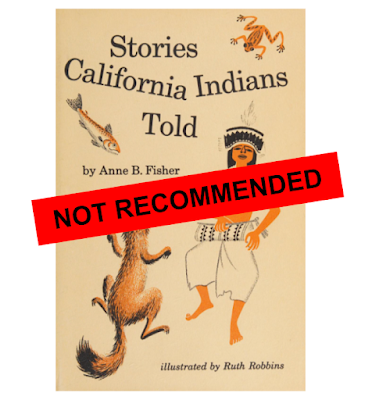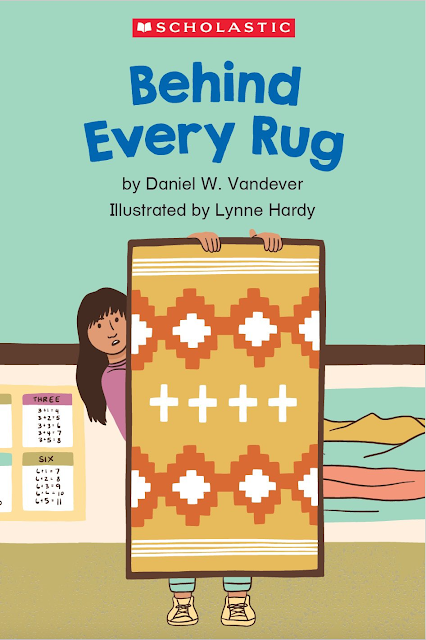A reader wrote to ask if I've read Back in the Beforetime: Tales of the California Indians by Jane Louise Curry.
The answer? I had not, but the reader's question prompted me to take a look.
It came out in 1987 from Margaret K. McElderry Books and again in 2001 from Aladdin. It is written by a person who (as far as I can tell) is not Native. Back in the Beforetime is one of several books Jane Louise Curry has written about Native peoples. I was able to get an electronic copy of her book. The first thing I do when taking a critical look at a book is to see if there's an Author's Note. There is one in this book. Reading it, I was pretty sure I would not recommend the book. Let me show you what I mean.
The first sentence of the note starts with "The Indian tales." That word -- tales -- is familiar. You see it with "folk" and "fairy" and "tall" but you rarely see it used with Bible stories. In my work, I've come to see that as a problem. Many "tales" are creation stories considered sacred to the people who tell them, but their stories aren't treated with the same respect given to Bible stories. You don't see Bible stories categorized or shelved as folktales. As I read further, would I find a lack of respect in Back in the Beforetime?
Let's see. The first sentence in its entirety is:
The Indian tales of Back in the Beforetime come from a number of California tribes, from the Klamath River region in the north to the inland desert mountains and the southern coastlands.
Here's the second one:
In reading through the many tales and fragments of tales recorded during the past century, I chose first those legends which could be woven together to tell the larger tale of Creation from the making of the world to man's rise to lordship over the animals, and then a selection of comic or trickster folktales which seemed to fit happily within that framework.
Hmmm. There's a lot to respond to in that sentence. "Lordship over the animals" sticks out and feels very white to me. And where, I wonder, was she finding these "tales and fragments of tales"? Reading to the end of the note, I don't see a list of her sources. That's important information. Knowing them would help us a lot. Her sources are likely ones collected by white people who had no idea what they were doing when they looked upon Native ways. Their lack of knowing meant their account is a misrepresentation of what was going on. The second part of that sentence tells us she chose legends that "could be woven together" to tell what she calls "the larger tale of Creation." What she did, when she wove some together, is a huge red flag. Why? Because she assumes that all these tribes are the same in how they think about the world. Many writers do that. They take something from one tribal nation's stories and then take something from a different one, and put them together as if that's fine. I don't think it is fine, particularly when books will be used in classrooms to teach children about Native peoples. In fact, anybody who reads the book is being miseducated.
Third sentence:
In several instances, where a story was incomplete or lacking in detail which could be found in a second version from the same or another tribe, I have told a composite tale.
See? She says right there that she pulled from several places (that she must assume are accurate) to create a "composite" tale. You might be thinking that I've being harsh. You might be thinking that Curry and her editor and others who did the same thing didn't know better. That they had good intentions. We can assume ignorance and good intentions but the product is still deeply flawed. The book came out in 1987. By then there were many people writing about misrepresentations. As far back as 1829, Native people were objecting! Take a look at
William Apes (Pequot) on Depictions of Native People in Stories. Many people defend what an author does by saying that nobody spoke up, then, and that it is unfair to challenge the author. People say that about
Gone With the Wind but when the movie came out, African Americans protested at a theater in 1940.
The New York Times article has photos of the protest. My point is that the author and editor may not have known they were publishing a flawed product--but that doesn't mean people weren't objecting. What anyone knows is shaped by who they know and what they read.
Back to Curry's note. In paragraph two, sentence one:
Several of the California tribes are represented in Back in the Beforetime by more than one tale, and many by none.
Reading that sentence, I thought that when I read the stories in her book, I'd see names of specific tribal nations. Some would be mentioned more than once because "more than one tale" was from one tribe. That was not the case. Here's the table of contents:
See? Titles of stories, but no tribally specific information. Is there some with each story? Easy enough to check. I turned to the first one:
There is no tribal nation mentioned after the title, and as I read the story, I didn't find one there, either. On the last page of that story, I see that after having created Grizzly Bear, "Old Man" was afraid of him So, Old Man retreated to his ice mountain and began to "hollow it out for a teepee." A teepee? I wonder about that because I associate tipis with Plains Indians. Curry finishes the story by telling us that the animal people Old Man created never saw him again, but sometimes, they'd see smoke coming from "the smokehole of the white teepee mountain and knew he was still there. They called his mountain Shasta. And so do we, for it is still is there." (Note: I am tempted to go down a rabbit hole wherein I search for "Old Man" and "Shasta" to see if I can find the source for Curry's story. I may do that later.)
In the second paragraph of the Author's Note, the second sentence is:
Being a storyteller rather than a folklorist, I have not sought to make a representative collection, but one which will offer to readers or to a storyteller's audience entertaining tales that can both stand alone and give some sense of what the context of a single story might have been within a tribe's traditional body of tales.
Entertaining? Ok. Stories do that, but within an educational context, the goal is education. Learning. Understanding. When the stories are about Native peoples, it is crucial that they be specific to a tribe. Without specificity, we all fall into stereotypical chasms that suggest all Native peoples are the same. We're not.
Next is the third paragraph. First sentence:
Many California tribes have dwindled or vanished.
Too many books use that sort of language. "Vanish" is especially outrageous. It means to disappear suddenly, without a trace. That's not what happened. Things don't just happen. Colonization, invasions, killings, removals... that's what happened, over a period of time. Native people fought back. There's more to say about that style of writing but I'll move on to the next sentences.
Others still struggle to preserve their traditions and holy places in a world of change. Of some, little trace is left but their tales, recorded long ago by folklorists and anthropologists.
Part of that "struggle" involves pushing back on misrepresentation that started with those long ago recordings. We could insert "white" in front of folklorists and anthropologists but unless you've studied how they got it wrong, inserting white doesn't help much.
The last sentence in the Author's Note:
For us their tales of the Animal People, in whom animal and human natures are mingled, are both comic and poignant, reminding us that once there was a time when Man was more fully at home in the natural world.
Comic? As in funny? Amusing? Ludicrous? Ridiculous? The author is definitely making a judgment that bothers me. But I remind myself that her sources may have that quality in them --- because the folklorist or anthropologist got things wrong.
That's the end of the author's note. And from what I've seen, my earlier thought that I'd not be recommending the book stands. I do not recommend Back in the Beforetime.
I encourage you to stop using it in your classrooms. And as always, if something I've said doesn't make sense or if you want me to say more, let me know in the comments.


























